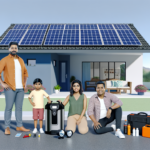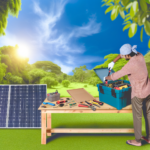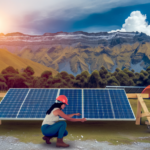Introduction to Solar Power Systems
Understanding Solar Energy
Solar energy is a renewable resource harnessed from the sun’s rays. This energy is captured using solar panels, which convert sunlight into electricity through the photovoltaic effect. Solar panels are composed of numerous solar cells made from semiconductor materials like silicon. When sunlight hits these cells, it excites electrons, creating an electric current. This direct current (DC) electricity is then converted into alternating current (AC) by an inverter, making it usable for homes and businesses. Even on cloudy days, solar panels can generate electricity, albeit at a reduced efficiency.
Benefits of Solar Power
The advantages of solar power are numerous and impactful:
- Environmental Benefits: Solar power is a clean, green source of energy. It reduces reliance on fossil fuels, thereby decreasing greenhouse gas emissions and mitigating climate change.
- Cost Savings: Once installed, solar power systems can significantly reduce or even eliminate electricity bills. Excess energy can be sold back to the grid in many regions, providing an additional financial benefit.
- Energy Independence: Solar power allows individuals and businesses to become less dependent on the grid, providing a reliable source of energy even during power outages.
- Low Maintenance: Solar power systems require minimal maintenance. Most systems come with warranties that last 20-25 years, ensuring long-term reliability.
- Increased Property Value: Homes equipped with solar power systems often see an increase in property value, making it a wise investment for homeowners.
Who Can Benefit from Solar Power Systems?
Solar power systems are versatile and can benefit a wide range of users:
- Homeowners: Residential solar power systems can drastically reduce household electricity bills and provide a reliable source of energy.
- Businesses: Commercial entities can lower operational costs and enhance their sustainability profiles by adopting solar power.
- Remote Areas: Off-grid solar systems are ideal for remote locations where traditional power infrastructure is unavailable or unreliable.
- Environmental Advocates: Individuals and organizations committed to reducing their carbon footprint will find solar power an effective way to achieve their goals.
- Government and Public Institutions: Schools, hospitals, and other public institutions can benefit from the cost savings and reliability of solar power, ensuring uninterrupted services.
In summary, solar power systems offer a sustainable, cost-effective, and reliable energy solution suitable for a diverse range of applications. Whether for residential, commercial, or remote use, the benefits of adopting solar energy are substantial and far-reaching.
Core Components of a Solar Power System
Solar Panels
Solar panels are the cornerstone of any solar power system. They are responsible for capturing sunlight and converting it into direct current (DC) electricity. Solar panels are composed of multiple solar cells made from silicon, a semi-conductive material. When sunlight hits these cells, it excites electrons, generating an electric current. The efficiency of a solar panel, typically ranging between 17% to 19%, determines how much sunlight is converted into usable electricity. Factors such as the type of panel, placement, and environmental conditions can influence this efficiency.
Inverters
Inverters play a crucial role in a solar power system by converting the DC electricity generated by solar panels into alternating current (AC) electricity, which is used by most household appliances and can be fed into the electrical grid. There are two main types of inverters: string inverters and microinverters. String inverters are centralized units that convert the DC electricity from all the panels in a system at once. Microinverters, on the other hand, are installed on each individual panel, allowing for more efficient energy conversion and better performance monitoring.
Battery Storage
Battery storage systems are optional but highly beneficial components of a solar power system. They store excess electricity generated by the solar panels for use during periods when the panels are not producing electricity, such as at night or during cloudy days. This stored energy can also serve as a backup during power outages. Common types of batteries used in solar systems include lead-acid, lithium-ion, and nickel-based batteries. The choice of battery depends on factors like cost, storage capacity, and lifespan.
Charge Controllers
Charge controllers are essential for systems that include battery storage. They regulate the voltage and current coming from the solar panels to prevent the batteries from overcharging, which can significantly reduce their lifespan. There are two main types of charge controllers: Pulse Width Modulation (PWM) and Maximum Power Point Tracking (MPPT). PWM controllers are simpler and less expensive, making them suitable for smaller systems. MPPT controllers are more efficient and better suited for larger systems, as they optimize the power output from the solar panels.
Mounting and Racking Systems
Mounting and racking systems are critical for the physical installation of solar panels. These systems secure the panels to rooftops or ground-based structures, ensuring they remain stable and optimally positioned to capture sunlight. High-quality mounting systems are typically made from durable materials like aluminum and stainless steel, which can withstand harsh weather conditions and minimize corrosion. Proper mounting not only ensures the longevity of the solar panels but also maximizes their efficiency by maintaining the optimal angle and orientation for sunlight exposure.
Types of Solar Power Systems
When considering a solar power system, it’s essential to understand the different types available to determine which best suits your needs. The three primary types of solar power systems are **Grid-Tied Systems**, **Off-Grid Systems**, and **Hybrid Systems**. Each has its unique features, advantages, and potential drawbacks.
Grid-Tied Systems
Grid-tied systems are the most common type of solar power system. These systems are connected to the public electricity grid and do not require battery storage. Here are some key points about grid-tied systems:
- Cost-Effective: Grid-tied systems are generally less expensive to install because they have fewer components compared to other systems.
- Net Metering: These systems can take advantage of net metering, where excess electricity generated by your solar panels is sent back to the grid, and you receive credits on your electricity bill.
- Reliability: Since you are connected to the grid, you can draw power from it when your solar panels are not producing enough electricity, such as during nighttime or cloudy days.
- Incentives: Grid-tied systems often qualify for state and federal incentives, which can significantly reduce the initial investment cost.
However, one major drawback is that grid-tied systems do not provide power during a grid outage for safety reasons. The system must shut down to prevent back-feeding electricity into the grid, which could endanger utility workers.
Off-Grid Systems
Off-grid systems are entirely independent of the public electricity grid. These systems are ideal for remote locations where connecting to the grid is impractical or too expensive. Key features of off-grid systems include:
- Energy Independence: Off-grid systems allow you to be completely self-sufficient, relying solely on solar power and other renewable energy sources.
- Fixed Energy Costs: Once installed, you won’t receive electricity bills, as you generate and store all the power you need.
- Modularity: These systems can be expanded over time to meet growing energy needs, making them flexible and scalable.
However, off-grid systems require a significant initial investment and a well-designed system to ensure year-round reliability. They typically include multiple charging sources, such as solar panels, wind turbines, and backup generators, to account for varying weather conditions. Additionally, off-grid systems may not qualify for some incentive programs available to grid-tied systems.
Hybrid Systems
Hybrid systems combine the best features of both grid-tied and off-grid systems. These systems are connected to the grid but also include battery storage to provide backup power during outages. Key benefits of hybrid systems include:
- Backup Power: Hybrid systems can provide electricity during grid outages, ensuring that essential loads, such as lighting and appliances, remain powered.
- Energy Storage: Excess energy generated by your solar panels can be stored in batteries for later use, such as during peak demand times or at night.
- Incentives: Like grid-tied systems, hybrid systems can qualify for state and federal incentives, reducing the overall cost.
The main disadvantage of hybrid systems is their higher cost compared to basic grid-tied systems. They require additional components, such as batteries and charge controllers, which increase the complexity and expense of the installation. However, for those who experience frequent power outages or want to maximize their energy independence, hybrid systems offer a compelling solution.
In summary, the choice between grid-tied, off-grid, and hybrid systems depends on your specific energy needs, location, budget, and desire for energy independence. Each system type has its unique advantages and potential drawbacks, so it’s essential to carefully evaluate your options to make an informed decision.
Choosing the Right Solar Power System for Your Needs
Assessing Your Energy Needs
Before investing in a solar power system, it’s crucial to understand your household’s energy consumption. Start by reviewing your electricity bills over the past year to determine your average monthly and annual usage. This will help you estimate the size of the solar power system you need. Consider any future changes that might affect your energy consumption, such as adding new appliances, expanding your home, or purchasing an electric vehicle. By accurately assessing your energy needs, you can ensure that your solar power system is appropriately sized to meet your requirements.
Evaluating Your Location and Sunlight Exposure
The efficiency of your solar power system largely depends on your location and the amount of sunlight your property receives. Factors such as geographic location, roof orientation, and shading from trees or nearby buildings can significantly impact solar energy production. Use tools like solar irradiance maps or consult with a solar energy expert to evaluate your site’s solar potential. Ideally, your solar panels should be installed on a south-facing roof with minimal shading to maximize sunlight exposure and energy generation.
Budget Considerations
Budget is a critical factor when choosing a solar power system. The cost of solar panels, inverters, battery storage, and installation can vary widely. While high-efficiency panels and advanced battery systems offer better performance, they also come with a higher price tag. It’s essential to balance your budget with your energy needs and long-term savings goals. Look for financing options, government incentives, and rebates that can help offset the initial investment. Remember, investing in a quality solar power system can lead to significant savings on your electricity bills over time.
Scalability and Future Expansion
When selecting a solar power system, consider its scalability and potential for future expansion. Your energy needs may change over time, and having a system that can be easily upgraded or expanded is beneficial. For instance, you might start with a grid-tied system and later add battery storage for greater energy independence. Ensure that the components you choose, such as inverters and charge controllers, are compatible with future upgrades. Planning for scalability ensures that your solar power system can grow with your energy needs, providing long-term flexibility and value.
By carefully assessing your energy needs, evaluating your location, considering your budget, and planning for future expansion, you can choose the right solar power system that meets your requirements and maximizes your investment.
Installation and Maintenance
DIY vs. Professional Installation
When it comes to installing a solar power system, you have two primary options: DIY installation or hiring a professional. Each approach has its own set of advantages and considerations.
DIY Installation:
- Cost Savings: One of the most significant benefits of DIY installation is the potential for cost savings. By doing the work yourself, you can avoid labor costs associated with professional installation.
- Learning Experience: Installing your own solar power system can be a rewarding educational experience, providing you with a deeper understanding of how your system works.
- Flexibility: DIY installation allows you to work on your own schedule, which can be particularly beneficial if you have time constraints.
However, DIY installation also comes with challenges. It requires a good understanding of electrical systems and local building codes. Mistakes can lead to inefficiencies or even safety hazards.
Professional Installation:
- Expertise: Professional installers bring years of experience and specialized knowledge, ensuring that your system is installed correctly and efficiently.
- Permits and Inspections: Professionals handle the necessary permits and inspections, ensuring compliance with local regulations.
- Warranty and Support: Many professional installations come with warranties and ongoing support, providing peace of mind and assistance if issues arise.
While professional installation may be more expensive upfront, the long-term benefits and reduced risk of errors often justify the cost.
Basic Maintenance Tips
Maintaining your solar power system is crucial for ensuring its longevity and optimal performance. Here are some basic maintenance tips:
- Regular Cleaning: Dust, dirt, and debris can accumulate on solar panels, reducing their efficiency. Clean your panels with water and a soft brush or cloth every few months, or more frequently if you live in a dusty area.
- Inspect for Damage: Periodically inspect your panels, inverters, and other components for signs of damage or wear. Look for cracks, corrosion, or loose connections.
- Monitor Performance: Use monitoring software to track your system’s performance. Sudden drops in energy production can indicate issues that need addressing.
- Trim Nearby Trees: Ensure that trees or other vegetation do not cast shadows on your panels, as shading can significantly reduce energy output.
- Check Inverter Status: The inverter is a critical component of your system. Regularly check its display for error messages or warnings.
Troubleshooting Common Issues
Even with regular maintenance, issues can arise. Here are some common problems and troubleshooting tips:
- Reduced Energy Output: If you notice a drop in energy production, first check for shading or dirt on the panels. If the panels are clean and unshaded, inspect the inverter for error messages. Faulty wiring or connections can also cause reduced output.
- Inverter Issues: Inverters can fail or malfunction. If your inverter displays an error code, consult the manual or contact the manufacturer for troubleshooting steps. In some cases, a simple reset can resolve the issue.
- Panel Damage: Physical damage to panels, such as cracks or chips, can affect performance. If you find damaged panels, contact a professional for repair or replacement.
- System Shutdown: If your system shuts down completely, check the main electrical panel and any circuit breakers. A tripped breaker can often be reset to restore power.
By staying proactive with maintenance and addressing issues promptly, you can ensure that your solar power system operates efficiently and reliably for many years.
Maximizing Efficiency and Performance
Optimal Placement and Angle
The placement and angle of your solar panels are critical factors that significantly impact their efficiency and performance. **Optimal placement** involves positioning the panels in a location that receives the maximum amount of sunlight throughout the day. Typically, this means installing them on a south-facing roof in the Northern Hemisphere or a north-facing roof in the Southern Hemisphere.
**Angle** is equally important. The tilt of the panels should be adjusted according to your geographical latitude to maximize exposure to the sun. For instance, if you live at a latitude of 30 degrees, your solar panels should ideally be tilted at an angle of 30 degrees. Seasonal adjustments can also be beneficial; a steeper angle in winter and a flatter angle in summer can help capture more sunlight as the sun’s position changes.
Using Energy-Efficient Appliances
To get the most out of your solar power system, it’s essential to pair it with energy-efficient appliances. **Energy-efficient appliances** consume less electricity, which means you can power more devices with the same amount of solar energy. Look for appliances with the **Energy Star** label, which indicates they meet energy efficiency guidelines set by the U.S. Environmental Protection Agency.
Here are some tips for maximizing energy efficiency:
– **Upgrade to LED lighting**: LED bulbs use up to 75% less energy than incandescent bulbs and last significantly longer.
– **Use smart thermostats**: These devices can optimize heating and cooling schedules based on your habits, reducing energy waste.
– **Opt for energy-efficient HVAC systems**: Modern heating, ventilation, and air conditioning systems are designed to use less energy while providing better climate control.
Monitoring and Managing Energy Use
Effective monitoring and management of your energy use can greatly enhance the performance of your solar power system. **Energy monitoring systems** provide real-time data on your energy consumption and solar energy production. This information can help you identify patterns and make informed decisions to optimize energy use.
**Key features of energy monitoring systems** include:
– **Real-time tracking**: Monitor how much energy your solar panels are producing and how much your household is consuming.
– **Alerts and notifications**: Receive alerts if your system is underperforming or if there are any issues that need attention.
– **Historical data analysis**: Review past performance to identify trends and make adjustments to improve efficiency.
By integrating these systems, you can ensure that your solar power system operates at peak efficiency, reducing your reliance on the grid and maximizing your return on investment.
Future Trends in Solar Technology
Advancements in Solar Panel Efficiency
In recent years, solar panel efficiency has seen remarkable improvements, making solar energy more viable and attractive. Early solar panels had conversion efficiencies of around 10%, but today, many panels exceed 20% and even 25%. This means that modern solar panels can convert nearly a quarter of the sunlight they receive into usable electricity. These advancements are largely due to continuous research and technological breakthroughs, including the development of new materials and manufacturing techniques.
One of the most promising advancements is the use of perovskite solar cells. Perovskites are a type of semiconductor that can absorb a wide range of light wavelengths, making them highly efficient. Recent research has shown that perovskite-silicon tandem cells can achieve efficiencies of up to 26.81%, a record-breaking figure. These tandem cells combine the strengths of both materials, capturing a broader spectrum of sunlight and converting it into electricity more efficiently.
Innovations in Battery Storage
As solar power becomes more widespread, the need for efficient energy storage solutions has become increasingly important. Innovations in battery technology are making it possible to store solar energy more effectively, ensuring a reliable power supply even when the sun isn’t shining. Lithium-ion batteries have been the standard for solar energy storage, but new technologies like flow batteries are emerging as strong contenders.
Flow batteries offer several advantages, including higher energy density, longer lifespan, and improved charging and discharging capabilities. These batteries use liquid electrolytes that can be easily scaled up, making them ideal for large-scale energy storage applications. Additionally, advancements in battery management systems are enabling better control and optimization of stored energy, allowing users to maximize their solar energy usage based on demand and grid conditions.
Smart Solar Systems and IoT Integration
The integration of smart technologies and the Internet of Things (IoT) is revolutionizing the solar industry. Smart solar systems use sensors and IoT capabilities to monitor and optimize solar panel performance in real-time. This allows for more efficient energy production and easier maintenance, as issues can be identified and addressed proactively.
Smart solar panels can adjust their orientation to track the sun, maximizing energy capture throughout the day. They can also communicate with other smart devices in a home or business, optimizing energy usage based on real-time data. For example, a smart solar system can work in tandem with smart thermostats and appliances to reduce energy consumption during peak hours, thereby lowering electricity bills.
Moreover, the use of data analytics and automation in smart solar systems is paving the way for a more interconnected and intelligent energy ecosystem. This not only enhances the overall efficiency of solar panels but also contributes to the broader adoption of renewable energy sources.
In summary, the future of solar technology is incredibly promising, with advancements in panel efficiency, battery storage, and smart systems driving the industry forward. These innovations are making solar power more accessible, efficient, and reliable, positioning it as a key player in the transition to a sustainable energy future.






